My Radish Experiment – Part 2
Now that the final book of my Radish series is fully published, I wanted to go over my latest numbers one last time so that others can use it as an example of how this platform works and performs. Of course, every author’s experience will differ, but the more information you have about something you haven’t tried before, the better the decision you’ll be able to make as to whether you think it’ll be the right fit for you. To help with that, I’ll also give some of my own thoughts on this whole experiment and which sort of authors or books I think it will benefit the most.
Not long ago I began an experiment with Radish Fiction by publishing an old 3-book romance series on their platform to see how it would do. In part 1 of this article, I published the sales numbers and my analysis of how books 1 and 2 fared, and now that book 3 has completed publishing, I’m going to continue my analysis with that.
I highly recommend reading part 1 first if you haven’t already done so, as this part will make a lot more sense if that’s fresh in your mind. And it’s especially important if you aren’t already familiar with Radish and how it works, as my initial article described all of those details that no one wants me to have to go through again (especially me). But I’ll do my best to mention the past data and analysis when relevant here, especially where it’s useful as a comparison.
That being said, there are a few things I’ll go over again quickly, for context.
A Quick Recap
For this experiment, I used a previously published 3 book romance series that sold well on Amazon back when it was initially released. For the Radish model, I chose to make these books a single story separated into seasons (1 book per season) using their Wait-to-Unlock pricing model. Because book 1 is permafree on other sites, I had to make it free on Radish as well. The other two books published at a rate of 1 episode (basically a chapter) each day, the final 6 published episodes are pay only, and the rest are set to a 2 hour wait to unlock time.
(If all of that sounds like gibberish to you, I again recommend having a quick read of part 1 before you continue – final warning!)
I should also note that my main analysis will be on data that is a couple of weeks old at this point, as I captured it shortly after book 3 was complete. I’m doing this on purpose, because my initial analysis was done when book 2 had recently completed so it gives a fairer comparison. However, after that I’ll quickly go over the most recent data to determine if it changes any of my conclusions.
Data Set 1 – Reference
For reference, I’m including the data breakdown image from part 1 since it’ll be easy to compare against without having to flip back and forth between blogs. I’ll refer to this spreadsheet as Data Set 1.
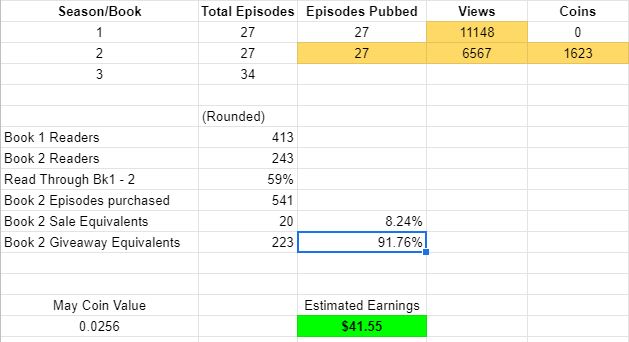
Data Set 2 Breakdown (as of July 28)
As I mentioned, I’ll mainly be analyzing the numbers taken shortly after book 3 was fully published (which was about a month after Data Set 1), and then briefly look at the difference in the numbers now, approximately 2 weeks later. I’ve had to expand the spreadsheet a bit to include book 3 numbers and calculations, but aside from changing the headers of the columns at the top to match the Radish terminology, it’s largely the same. I’ll refer to this spreadsheet as Data Set 2.
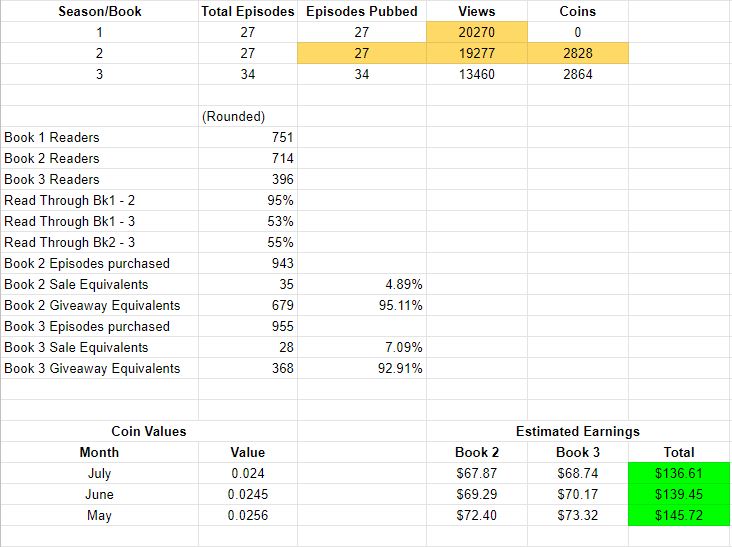
The top section are the raw numbers across all 3 books. This shows how many episodes each has, how many of those episodes are published (all of them, making this column a bit redundant now, but it was useful during my daily tracking), how many views each episode has had (how many times it was read), and how many coins the books have earned.
Below that is the section I use to attempt to break those numbers down into meaningful data, which I’ll go over in detail, and then finally you can see the totals.
I’ve expanded the totals section to break the amounts down both by book and overall, but you’ll also notice that it’s repeated 3 times. Unfortunately, that doesn’t mean I earned 3 times as much, I just wanted to show the difference in earnings based on the monthly difference in coin value – but more on that later.
Assumptions, Numbers and Analysis
Like last time, most of my analysis is just calculated from the raw numbers that Radish provides, with some assumptions having to be made due to lack of more detailed data. For instance, I make the assumption that each reader reads all chapters/episodes. I know that’s not correct, but it’s good enough to draw the conclusions I need. Sure, for the purposes of understanding read through and whether your book is interesting, it’s great to know whether it’s 1 person reading the entire book cover to cover vs a bunch of people reading part of it before giving up, but in terms of how many full copies of the books I’m giving away or are getting purchased, that distinction is less important. It’s also similar to how many KU readers try to calculate how many borrows a book has based on page reads.
Total Book Readers and Read Through
With that in mind, where you see Book # Readers in the table above, those are calculated by dividing the episode views of those books by the number of chapters published for them. For example, in Data Set 1, the first book had 413 readers but now in Data Set 2, book 1 is up to 751 readers.
While it’s interesting and useful to have the estimate of how many people have read each book, the real purpose of it here is to estimate the read through percentages.
Having an idea of the read through numbers of your own series or catalog is essential to improving as an author because it not only gives you an idea of how sticky your books are, but also provides you with a roadmap of where you need to focus on next to grow as an author. (I’d love to go into this topic in much greater detail as it’s so important and not always given enough attention, but it’s a topic that really deserves a post of its own, so I’ll add that to my todo list.)
Determining read through can get complicated (and is never perfect), but the good news is that it’s far easier to do on a series than on completely discrete books. That’s because MOST readers prefer to read a series starting on book 1. Even when each book in the series can technically be read as a stand-alone, if given the chance, I would wager that the VAST majority of readers would still start at the beginning. That doesn’t mean that they will continue after that first book, or that they’ll read all the books in the series, but for the most part they will typically start at the beginning and read the books in order.
In this case, where I only have this 3-book series up for sale and book 1 is free, it’s even more important to have a strong read through percentage, otherwise I wouldn’t earn any money at all. If we run with the assumption that readers are starting on book 1 and reading in order, I can calculate read through for each book by simply dividing one book’s reader count by the previous one.
When you look at those numbers in Data Set 2 (and compared against Data Set 1), the book 1 to 2 read through is interesting for a couple of reasons.
First, it’s very high, close to 100%! That’s a fantastic read through, as it means almost everyone that reads book 1 is reading book 2. However, as I noted near the end of my original blog, there’s a much less fantastic explanation for why this is likely the case.
Essentially, because of Radish’s Wait-to-Unlock model, any reader patient enough can read all or most of a book for free. When it comes to a series, then, unless the reader hates book 1, there is little reason for them not to continue reading. Still, if we look at this from more of a glass half full perspective, it’s gratifying to see such a high percentage of people are spending their time (if not their money) continuing on with the series. After all, there are plenty of other free books for them to move over to, which I assume most would do if they hated book 1.
The other thing I found initially surprising about that 95% read through rate was how much of a jump it was from my last analysis, when it was only 59%. Book 2 was fully published when I ran those numbers, but only had been for a day or two, so my first thought was that people were just catching up over time.
That may be part of it, but I think there’s a much more likely (and again, negative from an author’s point of view) explanation.
With the Wait-to-Unlock model, the author chooses a set number of chapters to be permanently pay at the end of the “story”. Because of the way I set things up, this means that when I ran the numbers right after book 2, the final 6 chapters were still pay only. Only over time, as new chapters for book 3 were published, did they revert to the Wait-to-Unlock/free model. Thus, my assumption here is that a large part of the difference between the two percentages were simply readers “waiting” for those pay only chapters to become free. Once the dam broke, so to speak, they flooded in to finish the book.
If this is the case, we should see some similar numbers with book 3 and, in fact, we do. The read through between books 1 and 3 and books 2 to 3 are virtually identical at 53% and 55%, and very similar to the 59% we saw when book 2 had its final chapters locked down for pay only, just as book 3 does now (and will continue to have going forward, now that the entire series is published).
What will be interesting to see is whether that number continues to climb over time. If all of those readers are strictly free only, they may never pay and that number may barely change. However, my hope is that at least some of the readers will be curious enough to find out how it all ends to spend a few of their coins to finish it off.
Book Sales/Giveaway Equivalents
As Radish charges 3 coins per episode, I calculate how many of each book’s episodes were purchased by dividing the coins earned for that book by 3. But as I explained in part 1, due to how Radish’s Wait-to-Unlock model works, it’s very unlikely that anyone is ever paying for all of the episodes in your book. At best, some readers are paying for some chapters, but it’s virtually impossible to really separate readers into true and discrete payer vs freeloader categories.
So instead, I decided to break things down into sale or giveaway “equivalents”, which simply means that I divide the number of episodes that were paid for by the number of chapters in that book, and that gives me the number of full book reads that were paid for. Everything else becomes a free giveaway.
Last time, book 2 had 20 sale equivalents (I was paid for 20 full copies of the book) and this time that number has increased to 35. That’s a 75% increase which sounds great, right?
As usual, numbers can be deceiving which is why you have to often look a little bit deeper for the truth. You’ll notice that the Sale Equivalents rows have percentages in their 3rd columns. This value signifies the percentage of books sold vs given away (and vice versa for the Giveaway Equivalents rows). And if you look at both data sets, you’ll see the same disturbing thing that I saw. To get that increase in sales, I had to give away a much higher number of books. Initially, of all of the book 2 equivalents read, I was only being paid for 8% of them, and I thought that was bad! This time around, although the number of books I sold went up by 75%, as a percentage of the total books being read, it is now under 5%. That’s almost a 40% drop!
Book 2 sales increased by 75%, but now make up less than 5% of the total books read.
The situation isn’t much better for book 3. I made 28 sale equivalents, but had to give away 368 copies to do it, putting my sales percentage at just over 7%.
As I mentioned in part 1, this is the true “cost” of this model, and depending on your situation, that may be too high. For a book you are trying to sell, you shouldn’t be only paid for 5 out of every hundred people that read it.
In general though, there isn’t much else to note about this section, the book 3 numbers look largely as expected, similar to how book 2 looked in Data Set 1.
Earnings
Which brings us to the final section of the spreadsheet, the coin values and earnings.
This time around I had to make a couple of slight adjustments to this section.
First, I had to break the earnings down by book now that I had data for more than one of them. The only real surprise here is that book 2 and book 3 both earned almost the exact same amount. I mean, the fact that they are almost the exact same is just a coincidence, but that book 3 has already caught up to book 2 is surprising. Could be that because of the final 6 chapters being pay only now, and with no other books coming there is no incentive to wait, those that want to finish up the series are doing so right away. Also, book 3 has more overall episodes than book 2, so there are more opportunities to spend coins. If those are the reasons, I would expect book 3 to continue to outpace book 2 and soon be earning more.
I sold more books in total, so my overall earnings went up (regardless of which row you look at, the differences between them are minimal, but I’ll get to why I repeated them shortly).
In fact, depending on which row you look at, my earnings increased by between 228 – 250%. That’s not too bad from a raw numbers perspective, given that I only published 1 more book. But again, whether it’s worth it really depends on how all those giveaways factor into your thinking. And quite honestly, $150 bucks for a 3 book series across more than 2 months isn’t really that exciting, even though it was fairly simple to set up and I haven’t had to spend any money advertising or put any extra effort or thought into it (aside from writing these articles).
But how did they fare against my Amazon earnings?
If you recall, these books are still for sale on Amazon, but as I haven’t touched them (or the rest of my catalog) in years, they earn very little. Still, they’re noteworthy as a point of comparison.
For the period between the two data sets, the entire series earned $35.35 on Amazon, but even if I use the lowest coin value row as comparison, Radish earned $95.06 (this month’s $136.61 minus last month’s $41.55). That means Radish earned about 169% more in the same time frame!
But remember, a great many free copies had to be given away to earn that.
How many?
Well, book 1 is permafree on Amazon, and during this time period I gave out 178 copies of that book.
During the same time period on Radish, I gave away 338 copies of book 1. Fair enough, it’s meant to be free so that’s not a problem.
But here’s the thing. I’m not giving any copies of book 2 or 3 away on Amazon, they’re books I would like to be paid for. But due to Radish’s Wait-to-Unlock model I’ve had to give away another 456 copies of book 2 and 368 copies of book 3.
I gave away 178 copies of book 1 to earn $35.35 on Amazon, but had to give away 1162 copies of the entire series to earn $95.06 on Radish.
That about sums that up, so take from it what you will.
The second adjustment I had to make to this section was in repeating the earnings row three times, and I did that for two reasons.
First, because despite the fact that there are 3 totals shown, none of them are completely accurate.
That’s because, like KU page reads, the Radish coin value fluctuates from month to month. As I didn’t keep track of how many coins were earned per calendar month, I really have no idea how many were earned under which rate, so the true earning is probably closer to an average of the 3 lines than any one line in particular. But as the numbers are so similar, I don’t think it really matters which one we focus on.
The second reason I wanted to show all 3 was to be clear on one of the biggest gripes Radish authors have about the new payment model, which, when laid out like this, looks very similar to the historical fluctuation and eventual drop of the KU page reads value.
When Amazon first introduced KU page reads, the first month had the highest payout value, and then the price slowly fell to its eventual stabilizing point, where it now hovers around, with minor fluctuations month by month. Radish has only had this pricing model for 3 months, but it’s already trending the same way. It’s too soon to tell if the payout rate has yet hit its bottom, but if it continues to mirror Amazon, then it still has a way to go.
Latest Numbers (as of Aug 11) and Weird stuff
Before I wrap this up, I wanted to very quickly show the latest Radish numbers, which were taken a couple of days from publication of this article, or about 2 weeks after book 3 was completely published.
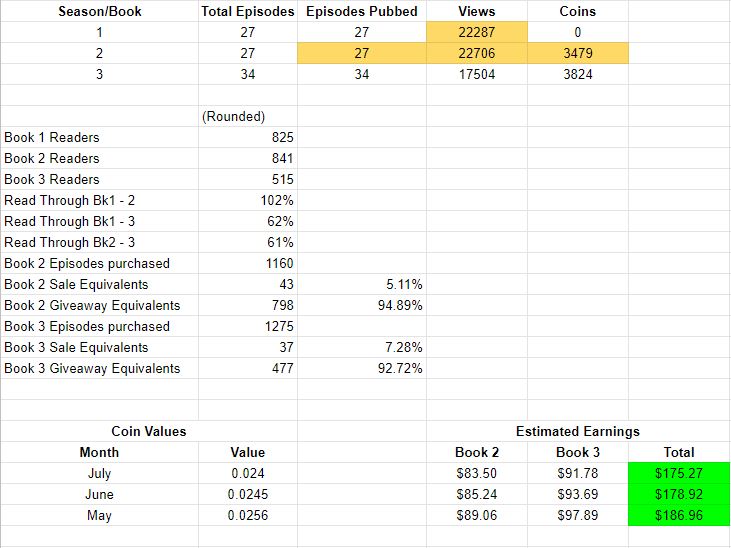
For the most part, things have continued to progress as expected, but there are a couple of surprises.
As I had hoped, the read through rate for books 2-3 continues to climb, but hasn’t yet gotten as high as I would like. Could be not as many of the freebie readers are choosing to pay for those final 6 chapters after all, or it could just be that not enough time has elapsed. After all, the difference between those other two data sets was around a month or so.
One eye opener is the book 1-2 read through rate, which has surpassed 100%! That could mean that there are at least some readers that are reading book 2 but not book 1. Or it could be that some people skipped episodes in book 1. That may seem odd, but it would track with some strange numbers I noticed when I looked at the per episode views. I didn’t drill into that level for these articles as it just becomes far more complicated and with very little extra value, but this one issue is definitely worth mentioning.
For instance, episode 27 of book 1 (the last chapter of the free book) had 1163 views, but episode 26 only had 696 views. Are THAT many people skipping to the end to see how things turn out? But it gets even stranger, because it’s not like there was this eventual decline chapter by chapter, leading to 696 and then that big jump to 1163. Aside from that big jump, the overall trend seems reasonable, but the individual numbers make little sense. A few examples:
- Episode 15: 851 views
- Episode 16: 782 views
- Episode 17: 750 views
- Episode 18: 821 views
- Episode 19: 797 views
- Episode 20: 923 views
And for fun, I charted the entire book 1 as a line graph, which I think illustrates the issue a lot better.
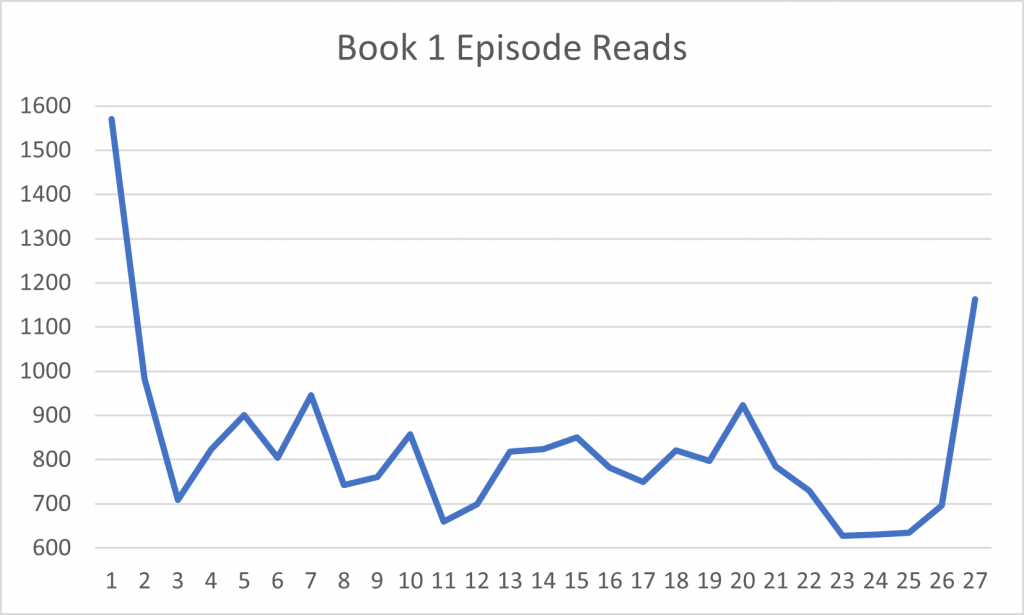
I mean, are people really just randomly reading chapters or, perhaps more likely, does Radish have some view tracking issues? Impossible to say, but very strange.
Overall though, the numbers are continuing to climb, and as expected, book 3 is now outpacing book 2 from an earnings perspective. What wasn’t expected, though, was that it’s doing so simply because it’s longer. In the last couple weeks, book 3 picked up 7 more sale equivalents, but book 2 picked up 8. But since book 3 has 7 extra episodes, it’s pulling in more money.
Conclusion and Recommendations
It may seem surprising given how often I mentioned it, but to be completely honest, giving away all of those free copies doesn’t really bother me, although I still think it’ll be (justifiably) a big deal for many others.
In my case, I’m using books that have already had their day in the sun, and they’ve been languishing for years. I’m not planning on doing anything else with them, and so giving away a bunch of free copies to get an extra couple hundred bucks isn’t really a big deal. But that definitely won’t be everyone’s feeling on the matter, and if these were new books, I would feel completely differently.
In fact, because of this, I would never actually recommend using Radish to anyone for their new books. I think it’s fine as an alternative source of income to use on your back catalog – but I don’t really see a path to big success. There is just no easy way to reliably market your books to their audience, and thus discoverability on the platform remains an issue.
And because of all the free giveaways, I wouldn’t even recommend using it for a new book as part of a wide strategy, as I would worry about the dilution all of those free copies would have on the broader market – thus hurting your sales elsewhere. I have no actual data to back this up, but I have a feeling that the percentage of Radish readers that also read on other platforms is likely very high, which is why I would fear that dilution.
In my opinion, as it stands now, Radish only seems like a good option for older, back catalog material that you aren’t planning on doing anything else with anyway.
Of course, your experience may differ, so if you have anything to add to the discussion, please leave your comments below, or feel free to email me.


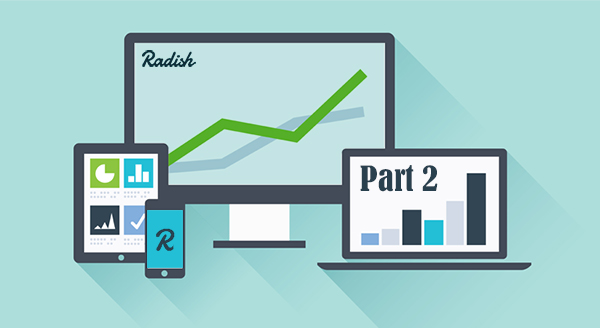






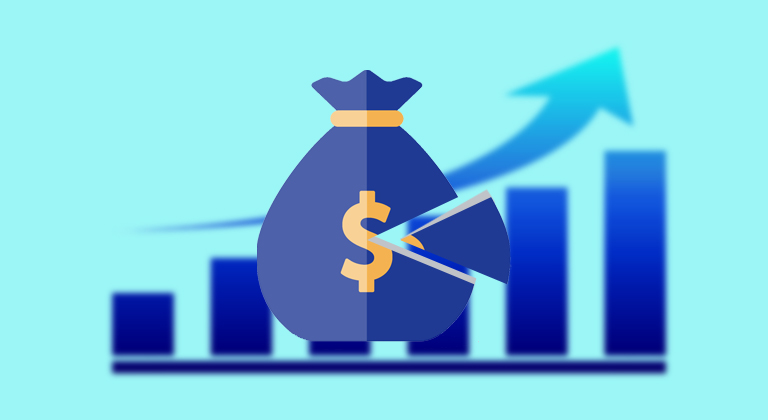


As a radish reader, I would say that the most common reason for different numbers for chapters would be people opening the chapters but not reading them until at least a decent amount are open. A lot of the promotions get you to read 3-20 chapters of a book. I have at least twenty books where I have opened all the free chapters but not actually read them as I like to read continuously when the book is good. And if I am reading it, I sometimes buy the chapters with free coins and then have trouble remembering where I’ve actually read up to.
Thank you so much for publishing this experiment! I’m new to Radish, and this helps a lot. Did you have to email them and request that your first 27 episodes be made available for free? In the dashboard, upon setting up a new story, I see a drop-down menu for first free episodes, but it only gives 3 options: 5, 10, or 20 episodes.
I also noticed in Radish’s content policy, “wait to unlock” states that a work must not be available for free on other platforms. Is making the first book’s worth of episodes free enough to disregard this? Did you confirm that with a representative at Radish?
Hi Angela – glad my experiment was useful for you! Similar to Amazon, Radish has a policy that if a work is free elsewhere, it has to be free on Radish which was why I had to have the entire book 1 free as it is permafree everywhere else. I’m not sure whether you can do that through the site, as I had been talking to their support via email and if I remember correctly, they set it up that way. I had to talk to them anyway to get the Wait to Unlock stuff set up as it wasn’t an option I could select myself, I had to email all the details I wanted and they did it on the back end although that may have changed since then. They did say that they were working on making that one of the options, but I haven’t published anything new on Radish since that experiment so I don’t know if they ever did.
Their support team is helpful, but I found it did sometimes take days for them to respond… but reaching out to them would be what I suggest. They can either set it up for you the way you want, or instruct you on the way to do it via the UI now.
Good to know. I’ll reach out to them before uploading my first free episodes then. Thank you so much! I really appreciate your insight into Radish! : )
Thanks for the detailed analysis!